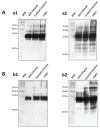Rapid, Effective, and Versatile Extraction of Gluten in Food with Application on Different Immunological Methods
- PMID: 33808639
- PMCID: PMC8003464
- DOI: 10.3390/foods10030652
Rapid, Effective, and Versatile Extraction of Gluten in Food with Application on Different Immunological Methods
Abstract
One of the main concerns in gluten analysis is to achieve efficient extraction of gluten proteins. Conventional ethanol-based extraction solutions are inefficient and, because of this, it is necessary to use reducing agents or acids for proper solubilization. The extraction recommended by CODEX Standard 118-1979 (revised 2008) utilizes Cocktail solution (patent WO 02/092633 A1). However, it is harmful with a disgusting odor and is not compatible with some immunological techniques. Here, the versatility and extraction capacity of a new Universal Gluten Extraction Solution (UGES) (patent ES 2 392 412 A1) were evaluated using different methodological conditions, food matrices, and various immunological methods. UGES includes safer compounds for both the user and the environment, and it displayed similar extraction efficiency to that of the extraction method recommended for sandwich enzyme-linked immunosorbent assay (ELISA). The extraction time was significantly reduced from 100 to 40 min, depending on the type of the sample. Furthermore, unlike the currently used solution, UGES is compatible with competitive ELISA.
Keywords: celiac disease; gluten extraction solution; gluten proteins; gluten-free diet.
Conflict of interest statement
Ángel Cebolla is the founder and current director of Biomedal S.L. The other authors declare no conflicts of interest.
Figures





References
-
- Mena M.C., Sousa C., Mena M.C., Sousa C. CHAPTER 16. Analytical Tools for Gluten Detection: Policies and Regulation. [(accessed on 27 January 2021)];OmniaSci. Monogr. 2015 :527–564. Available online: http://www.omniascience.com/monographs/index.php/monograficos/article/vi....
Grants and funding
LinkOut - more resources
Full Text Sources
Other Literature Sources

